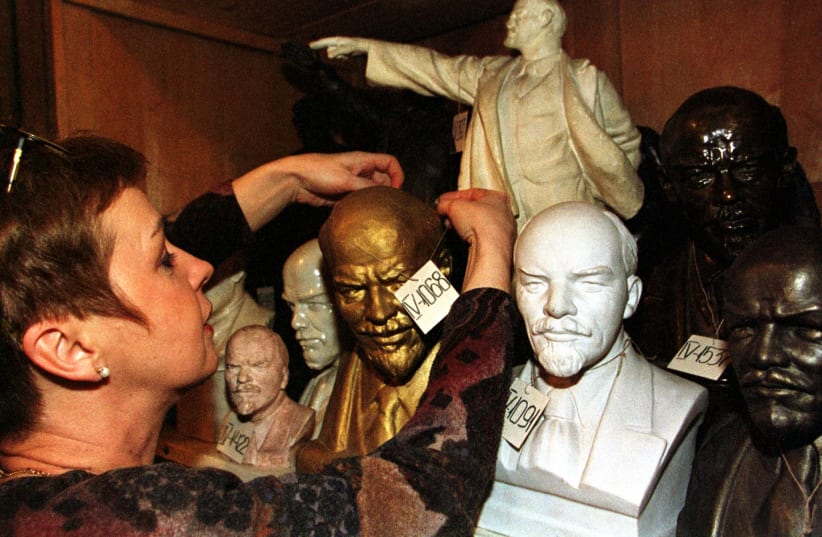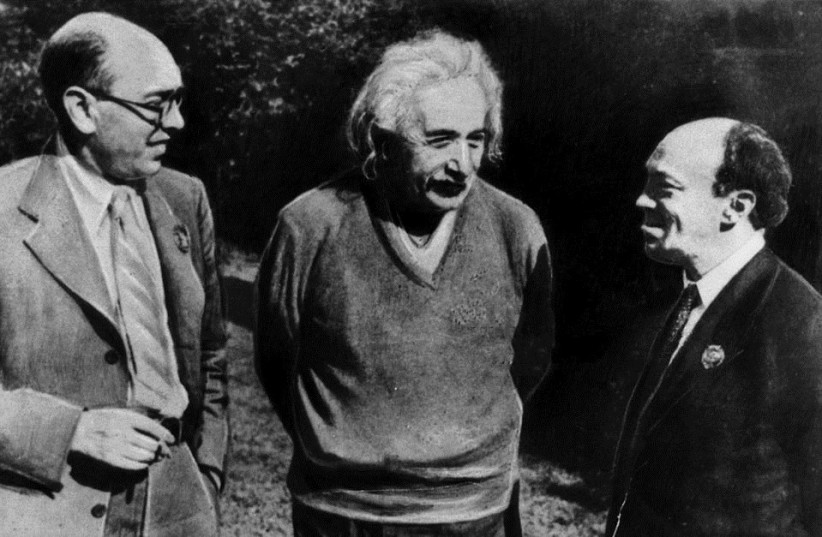First, let’s establish what How the Soviet Jew Was Made is not about. It’s not about refuseniks and emigrés.
The label “Soviet Jew” – as usually applied – was coined by outsiders, literary scholar Sasha Senderovich points out in this groundbreaking book.
“During the Cold War, Jews in the United States and other Western countries rallied to the cause of ‘saving Soviet Jews,’ as the slogan at the time had it, referring to advocacy on behalf of Jews who wanted to emigrate from the USSR between the 1960s and the early 1990s,” writes Senderovich, an assistant professor at the Department of Slavic Languages and Literature at the University of Washington, Seattle.
“During the Cold War, Jews in the United States and other Western countries rallied to the cause of ‘saving Soviet Jews,’ as the slogan at the time had it, referring to advocacy on behalf of Jews who wanted to emigrate from the USSR between the 1960s and the early 1990s.”
Sasha Senderovich
Before the Holocaust, assimilation and emigration diminished Russia’s Jewish population to today’s meager numbers, great struggles were waged to reforge their ancestors into a superior breed of human – the New Soviet Man. Focusing on two decades that follow the 1917 revolution, Senderovich draws on prose, poetry and film to trace this purported process of transformation.
In this book, literature comes first, history is mixed in second. Thus, discussion of Isaac Babel, David Bergelson and Moyshe Kulbak acquires a panoramic perspective. Same goes for Solomon Mikhoels, Venyamin Zuskin and other stars of theater and film.
No, these artists don’t follow any program of the Communist Party. They are asking questions others won’t ask, such as Who am I? What’s a man to do in these turbulent times? A reader prone to thinking in messianic terms will detect messianic allusions – i.e., transposition of Redemption and Communism – both between the lines of this book and in much of the underlying material.
When the Jews of the Soviet Union migrated to the cities
How the Soviet Jew Was Made is a story of a massive migration. Suddenly allowed to leave the Pale of Settlement after the February 1917 revolution, millions of Jews take off for Moscow, Petrograd and other big cities. (Senderovich’s family ends up in Ufa, an industrial city near the Ural Mountains, where he was born.)
Migrants from the Pale are weighed down by the legacy of poverty and ignorance of their shtetlekh.
Senderovich begins and ends this book with Babel. In the short story “The End of the Almshouse,” Babel describes Jewish paupers who, post-revolution, are evicted from their shelter on the grounds of the cemetery and are making their way to Odessa.
Here is the concluding passage:
“The heat tormented the heap of rags that was dragging itself across the earth. Their road lay along a joyless, scorched and stony highway past wattle-and-daub shanties, past fields choked by stones, past bombed-out houses, past the Plague Hill. Once upon a time in Odessa, this inexpressibly melancholy road had led from the town to the cemetery.”
“Dragging” across scorched earth is the opposite of a spirited march into the bright future. The paupers, whom Babel describes as an inanimate “heap of rags,” are messengers of the cemetery encroaching on the city. Incongruent ambulation – make that wandering – of Jewish characters is what the making of a Soviet Jew is about.
Babel is a trickster deeply influenced by hassidic stories about Hershele Ostropoler. Being a Russian and Yiddish speaker, Senderovich shows how young Babel recasts the hilarious short story “Shabos-nakhamu” in Russian. Also, with Senderovich’s guidance, we see Babel, Hershele-like, trick Soviet censors and sneak in a verboten reference to the Holodomor, the famine Stalin had engineered to tame Ukraine, into “Karl-Yankel,” a short story about circumcision.
Senderovich doesn’t reheat old material. He provides fresh insight, as well as material few have seen. I’ve reread Babel multiple times, but Senderovich has made me eager to return to this magnificent writer.
Similarly, I had little understanding of Bergelson’s Judgment, a novel that has been wrongly dismissed as propaganda. Senderovich, who co-translated Judgment from Yiddish, demonstrates that it’s a Gothic novel built around a ruthless head of secret police in a town rife with spies and smugglers. I’ve just ordered a copy.
Apropos propaganda, Senderovich devotes much attention to two Soviet films – Seekers of Happiness and The Return of Neitan Bekker. Both are about the challenges formerly Russian Jews face as they return from the West to begin new lives in the USSR. This reverse migration did happen, albeit on a small scale.
Consider the opening of Seekers:
A schemer named Pinya (played by Zuskin) sits on the deck of a steamship. A stereotypical luftmensch, a man of air, Pinya poses a question to a fellow passenger: “How much do you think a steamship like this could cost, approximately, of course?”
“Why? Do you want to buy it?”
“No, it’s just an interesting question.”
Surely, the viewer can see that Pinya, with his interest in the price of everything, would resist transformation into a New Soviet Man. And indeed, things go sideways after his family reaches the collective farm (Royte Feld) in the Jewish Autonomous Oblast in the Soviet Far East.
Neitan Bekker, with a cast that includes Mikhoels as Neitan’s father, shows the troubled readjustment of a Jewish bricklayer who has returned to the USSR from New York. According to the script, America had made Neitan into a “socially crippled freak.”
Senderovich also shines the light on writer, poet and ethnographer Kulbak, whose novel The Zelmenyaners captures a Jewish family’s adjustment to the Soviet era. In 1934, when Part II of this novel neared publication, the USSR Union of Writers mandated that writers follow specific rules of character development, forcing Kulbak to retrofit his unconforming work.
With socialist realism splitting art into progressive and retrograde, critics became enforcers of new rules. Consider the lambasting a critic named Yasha Bronshteyn gave to Bergelson’s Judgment. Rather than develop a new literary style worthy of political transformation around him, Bergelson had “bergelsonified the revolution instead,” Bronshteyn wrote.
Of course, Bergelson did just that! What else is an artist to do? As Bergelson’s and Senderovich’s other subjects struggle to understand the role of Jews in post-revolutionary Russia, they “bergelsonify” and “babelize” and “kulbakize.”
Life is hard on writers and actors, and Senderovich’s characters received a peculiarly Stalinist brand of remuneration for their efforts. Kulbak was executed in 1937, Babel in 1940. Mikhoels was assassinated in 1948, and Bergelson and Zuskin were swept up into Stalin’s final push to decapitate Soviet Jewish culture by killing 13 prominent Jews.
The night of their execution in Moscow’s Lubyanka prison – August 12, 1952 – is known as the Night of the Murdered Poets.
The writer’s novel The Dissident is forthcoming from Farrar, Straus and Giroux in June.
How the Soviet Jew Was MadeBy Sasha SenderovichHarvard University Press352 pages; $47.94

